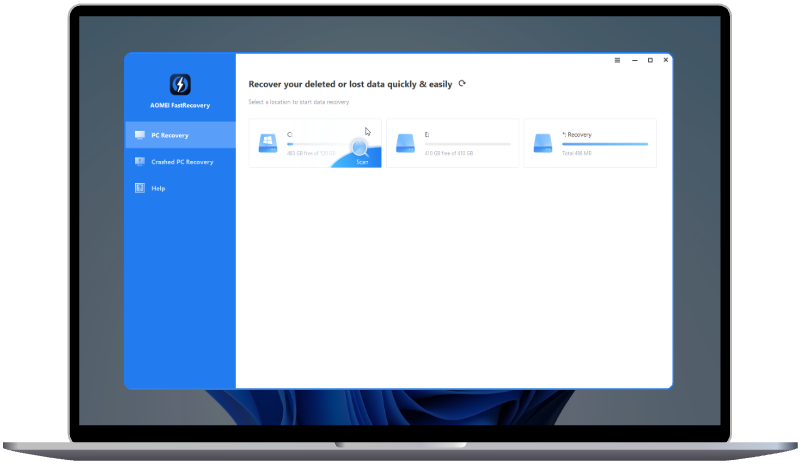[Full Guide]: How Do I Edit the Partition Size?
This article introduces a versatile partition assistant, showing you how to effortlessly edit partition sizes with ease.
How to Edit Partition Size with Ease?
When it comes to editing partition size in Windows, many users default to using the built-in Disk Management tool. However, there are several limitations while using it to edit partition sizes. To overcome these restrictions, we recommend AOMEI Partition Assistant, a professional disk management tool that offers greater flexibility for partition editing.
- All-in-one hard disk management tool for optimal performance.
- Fully compatible with Windows 11, 10, 8.1/8, and 7.
- Equipped with an intuitive and user-friendly interface.
➤ Before You Do
- Download and install AOMEI Partition Assistant Standard.
- Create backups of your essential data in case of unexpected failures.
- Close all applications and stop any processes using the drive you plan to edit.
AOMEI Partition Assistant Standard offers a range of tools for editing partition sizes, such as shrinking, extending, merging partitions, and allocating free space. Each of these methods is explained in detail below.
Option 1. Shrink a Partition
Shrinking partitions can be necessary when you need to create a new partition or free up space for system performance. AOMEI Partition Assistant Standard includes the "Resize /Move Partition" feature to edit partition sizes in Windows. Here’s a step-by-step guide:
Step 1. Launch AOMEI Partition Assistant, right-click the partition that you want to shrink (here is D:), and select "Resize /Move Partition".
Step 2. In the pop-up window, drag the boundary left or right to reduce the partition size, then click "OK".
Step 3. You can preview the shrink operation by viewing the "Pending Operations". If everything looks correct, click "Apply" and "Proceed" to commit the operation.
Step 4. Allow the process to complete. Once finished, you will notice that the D: partition has been successfully shrunk.
Option 2. Extend a Partition
Additionally, you may need to extend a partition to store data or improve system performance. Follow these steps below to do so using the "Resize /Move Partition" feature:
Step 1. Similarly, right-click the partition that you want to extend (here is C: ) and select "Resize /Move Partition".
Step 2. In the pop-up window, drag the boundary to the right to enlarge the partition and click "OK" to confirm.
★ For optimal safety and efficiency, you can enable the option "Using new mode to resize/move partition in the fastest and safest way". This ensures a faster, more secure partition resizing process, particularly for NTFS partitions. Even if the process is interrupted or the software is unexpectedly terminated, your data will remain intact.
Step 3. You can preview the shrink operation by viewing the "Pending Operations". If everything looks correct, click "Apply" and "Proceed" to commit the operation.
Step 4. Allow the process to complete. Once finished, you will notice that the D: partition has been expanded.
Option 3. Merge Partitions
If you have several small partitions that are no longer needed to be separated, merging them can optimize your disk layout and make better use of space. What’s more, you can also merge partitions to extend one using adjacent unallocated space. Here’s how to merge partitions with AOMEI Partition Assistant:
Step 1. Launch AOMEI Partition Assistant, right-click the partition (here is C:) you want to merge, and click "Advanced" > "Merge Partitions".
Step 2. In the pop-up window, select the partitions you want to merge and click "OK" to continue.
Alternatively, you can tick unallocated space to merge it into your partition. For example, merging the D: partition and unallocted space.
Step 3. You can preview the shrink operation by viewing the "Pending Operations". If everything looks correct, click "Apply" and "Proceed" to commit the operation.
Step 4. Wait for the process to be finished.
Option 4. Allocate Free Space
Sometimes, you may need to reallocate space from one partition to another. For an easier and faster process, consider using the Allocate Free Space feature. With this option, you can directly transfer free space from the source partition to the target partition.
Step 1. Right-click the partition that you want to allocate free space from (here is D:), and select "Allocate Free Space".
Step 2. Type in the size of the free space that you want to cut from the D: partition and this free space will be directly added to the target partition.
Step 3. You can preview the shrink operation by viewing the "Pending Operations". If everything looks correct, click "Apply" and "Proceed" to commit the operation.
Step 4. Wait for the process to be finished and check if the target partition has been expended.
Summary
Overall, AOMEI Partition Assistant stands out with its comprehensive features and user-friendly design, which allows you to resize partitions in Windows PCs. In addition to editing, this professional tool supports creating, moving, and cloning partitions, helping you easily and efficiently manage hard drives. If you want to edit partition size in Windows Server, consider choosing the Server edition to unlock more advanced features.

